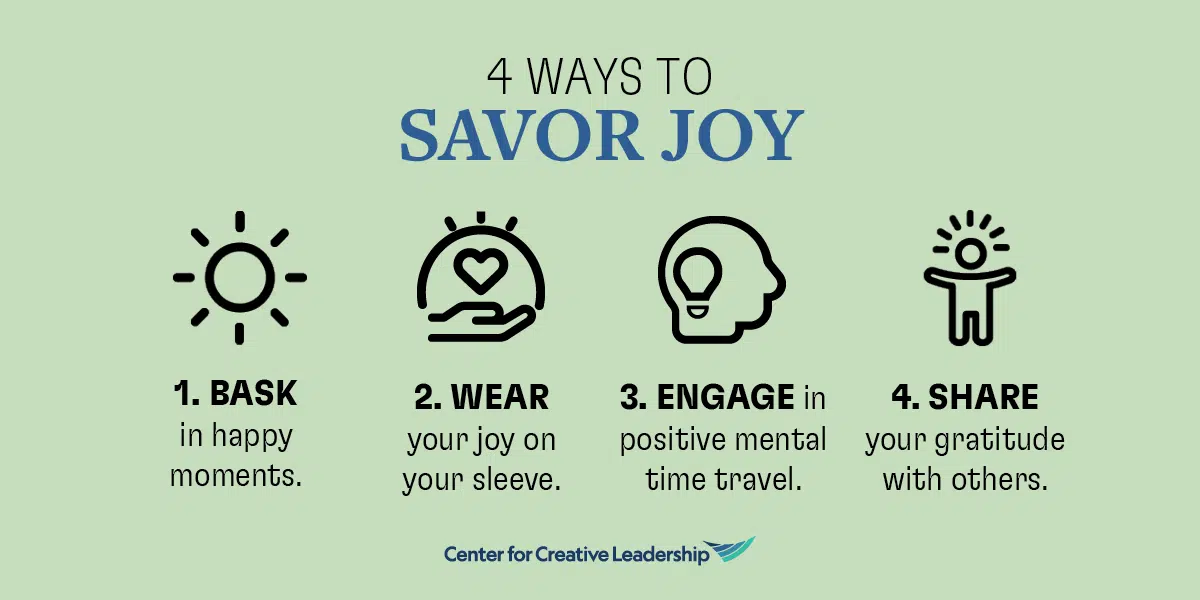’Tis the season to be jolly!
At least, that’s what they say. But for many of us, the holiday season can feel more like the season of stress, long lines, and countdowns. Whether we’re worried about meeting deadlines or in-laws, many of us muddle through the holidays and return to work wondering where the time went.
While some of the events to come over the next few weeks are inevitable, there’s a helpful technique you can use to help maximize your joy this holiday season — it’s called savoring.
Savoring is the scientific term for deliberately enhancing and prolonging your positive moods, experiences, and emotions.
You’ve probably done it before. Perhaps you closed your eyes to help you appreciate a moving symphony performance or stared in awe at your infant’s smile, trying to make sure you remembered every aspect of that moment. It’s important to note that savoring is not a mood or emotion itself, but rather a way of approaching positive emotions. For instance, you could savor feeling awe, interest, delight, love, pride, amusement, or contentment.
Why Savoring Is Linked to Happiness
Consciously savoring the good things in life is important because neuroscience research suggests that our brains have a negativity bias. Negative things tend to stand out in our minds, while positive things tend to be easily dismissed or forgotten. This makes sense from an evolutionary standpoint, given that remembering mistakes and bad experiences (like eating a poisonous fruit or being attacked by a wildcat) was important for survival.
But now, constantly ruminating over what went wrong probably does more harm than good. According to our former board member and positivity expert Barbara Fredrickson, people who see more positive than negative things in their lives tend to be more happy and successful, as well as more resilient as leaders.
Considering this, it’s perhaps not surprising that savoring — or being good at taking in good things — is linked to increased employee wellbeing, happiness, life satisfaction, and decreased depression.
In fact, some research suggests that savoring may be the secret behind why money doesn’t often buy happiness: As people become wealthier, they stop savoring the little things, so while their wealth increases, their savoring doesn’t, and neither does their happiness.
Savoring is also uniquely tied to stress. People who are under a lot of stress tend to have a hard time savoring things. But when stress is lifted, savoring seems to automatically kick in. Think of how good it feels to enjoy a quiet morning after a big deadline or to get to a quiet hotel room after a rough day of travel.
Neuroscience research shows that sustained activation of a region of your brain called the ventral striatum is related to both savoring and lower levels of cortisol (a stress hormone), suggesting the possibility that one might help suppress the other.
How Leaders Can Savor Joy & Maximize Their Holidays
Ready to try this positivity booster yourself? Science suggests that these 4 strategies can help you savor the holidays, the joy of the season, and the last days of the year:
4 Ways to Savor the Joy
1. Bask in happy moments.
Much like the practice of mindfulness, this type of savoring involves being present in the current moment and aware of sensory information. But unlike mindfulness, which emphasizes detached observation, in-the-moment savoring involves actively seeking out and soaking in the positive emotions.
This comes more easily when you set your intentions ahead of time regarding where, when, and what you’re going to savor. For instance, if you plan to savor your family holiday dinner, you might notice more of the little quirks that you love about your relatives, feel more grateful for your time together, and be less perturbed by a snide comment or a dry turkey.
Try it out: Try selecting a few specific moments or events over the next week that you plan to savor. Maybe it’s watching loved ones unwrap gifts, savoring the taste of your favorite holiday food, or being fully present when the clock strikes midnight on New Year’s Eve. Whatever the occasion, remember to take in the enjoyable sensory, emotional, and relational aspects of the experience and hold on to them for as long as you can.
2. Wear your joy on your sleeve.
Another way to elevate your positive experiences is through your non-verbal behaviors and expressions. We typically think of our physical reactions as simply the result of our emotions (for example, we smile because we feel happy).
However, science suggests the chain reaction goes both ways — smiling actually makes us feel happier, while hunching our shoulders and crossing our arms can make us feel more upset.
Try it out: This holiday season, try intentionally laughing, smiling, hugging, exchanging high fives, jumping for joy, and doing the happy dance to amplify your happy moments.
Access Our Webinar!
Watch our webinar, Practicing Gratitude: Why Giving Thanks Leads to Resilience, and learn the science behind gratitude and the impact it has on social, physical, mental, and emotional outcomes.
3. Engage in positive mental time travel.
Even if you aren’t experiencing something positive in the present moment, you can still practice savoring. We all have the ability to “time travel” within our minds to a more positive moment — whether it’s sometime in the past or in our anticipated future. Studies show that vividly reminiscing over positive experiences and eagerly anticipating future joyful occasions can boost your happiness levels, both in the moment and over time.
Try it out: Think about a time when you felt so happy, you thought you would burst. Remember how you felt in that moment (Giddy? Grateful? Excited?). Replay the event in your mind as if you were reliving it. Remember what you were thinking, seeing, doing. Recall who else was there and why that moment was so special.
Alternatively, you could take a moment to think about what aspect of the upcoming week you’re most excited about. Really immerse yourself in the vision of the positive things that could happen.
4. Share your gratitude with others.
While the first 3 savoring strategies can be done solo, this last one requires connecting with other people. Research suggests that sharing positive events with others is a great way to further amplify and savor the good things in your life. This strategy works best when you share with someone you’re close to and when that someone is likely to mirror back your positive emotions.
This creates an upward spiral of positivity. In fact, some research suggests involving others in your savoring can not only increase the positive impact of events but can also boost your mental and physical resilience.
This is consistent with our findings about the importance of gratitude in the workplace, too.
Try it out: Do some savoring with others this holiday season by taking the time to connect with people who are important to you. Get hot chocolate with a valued colleague, or put aside work to spend quality time with a family member you don’t get to see often. Use the opportunity to share what’s going well in your world, reminisce over a good experience you both shared, or let them know how grateful you are to have them in your life.
Of course, all new habits take some practice, so don’t be frustrated if you forget to use these strategies or if you don’t feel positive results right away. Just keep them in your back pocket and try them again later. With time and practice, these savoring strategies will help you savor the holidays, bring joy to your world, and ring in a happier year.
Ready to Take the Next Step?
Help your people be intentional as they cultivate positivity and savor joy during the holidays and other times. We can partner with your organization to create a customized learning journey for your leaders using our research-based modules. Available leadership topics include authentic leadership, emotional intelligence, resilience training for employees, and many more.









